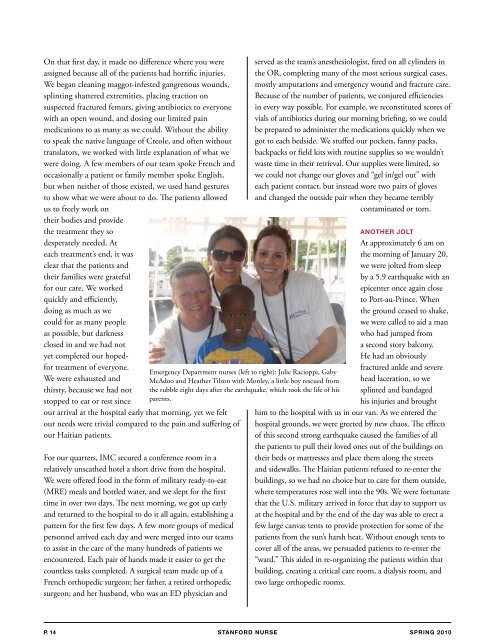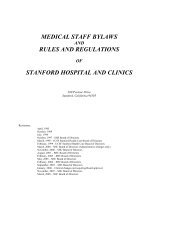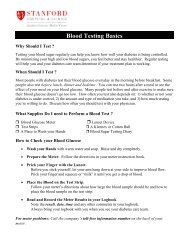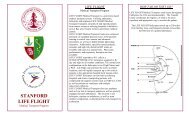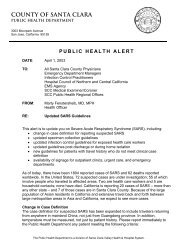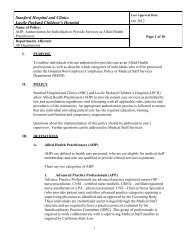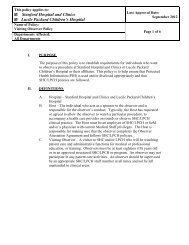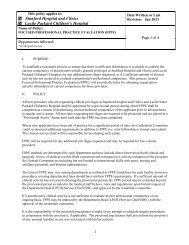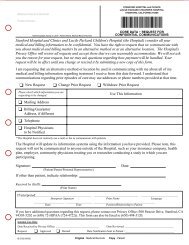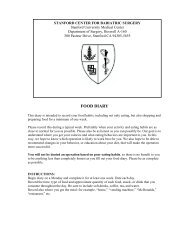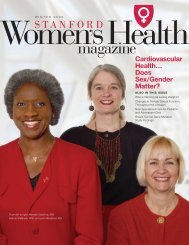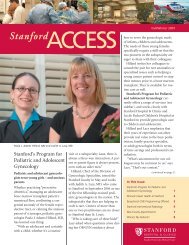SpRiNG 2010 - Stanford Hospital & Clinics
SpRiNG 2010 - Stanford Hospital & Clinics
SpRiNG 2010 - Stanford Hospital & Clinics
You also want an ePaper? Increase the reach of your titles
YUMPU automatically turns print PDFs into web optimized ePapers that Google loves.
On that first day, it made no difference where you were<br />
assigned because all of the patients had horrific injuries.<br />
We began cleaning maggot-infested gangrenous wounds,<br />
splinting shattered extremities, placing traction on<br />
suspected fractured femurs, giving antibiotics to everyone<br />
with an open wound, and dosing our limited pain<br />
medications to as many as we could. Without the ability<br />
to speak the native language of Creole, and often without<br />
translators, we worked with little explanation of what we<br />
were doing. A few members of our team spoke French and<br />
occasionally a patient or family member spoke English,<br />
but when neither of those existed, we used hand gestures<br />
to show what we were about to do. The patients allowed<br />
us to freely work on<br />
their bodies and provide<br />
the treatment they so<br />
desperately needed. At<br />
each treatment’s end, it was<br />
clear that the patients and<br />
their families were grateful<br />
for our care. We worked<br />
quickly and efficiently,<br />
doing as much as we<br />
could for as many people<br />
as possible, but darkness<br />
closed in and we had not<br />
yet completed our hoped-<br />
for treatment of everyone.<br />
We were exhausted and<br />
thirsty, because we had not<br />
stopped to eat or rest since<br />
our arrival at the hospital early that morning, yet we felt<br />
our needs were trivial compared to the pain and suffering of<br />
our Haitian patients.<br />
For our quarters, IMC secured a conference room in a<br />
relatively unscathed hotel a short drive from the hospital.<br />
We were offered food in the form of military ready-to-eat<br />
(MRE) meals and bottled water, and we slept for the first<br />
time in over two days. The next morning, we got up early<br />
and returned to the hospital to do it all again, establishing a<br />
pattern for the first few days. A few more groups of medical<br />
personnel arrived each day and were merged into our teams<br />
to assist in the care of the many hundreds of patients we<br />
encountered. Each pair of hands made it easier to get the<br />
countless tasks completed. A surgical team made up of a<br />
French orthopedic surgeon; her father, a retired orthopedic<br />
surgeon; and her husband, who was an ED physician and<br />
Emergency Department nurses (left to right): Julie Racioppi, Gaby<br />
McAdoo and Heather Tilson with Monley, a little boy rescued from<br />
the rubble eight days after the earthquake, which took the life of his<br />
parents.<br />
served as the team’s anesthesiologist, fired on all cylinders in<br />
the OR, completing many of the most serious surgical cases,<br />
mostly amputations and emergency wound and fracture care.<br />
Because of the number of patients, we conjured efficiencies<br />
in every way possible. For example, we reconstituted scores of<br />
vials of antibiotics during our morning briefing, so we could<br />
be prepared to administer the medications quickly when we<br />
got to each bedside. We stuffed our pockets, fanny packs,<br />
backpacks or field kits with routine supplies so we wouldn’t<br />
waste time in their retrieval. Our supplies were limited, so<br />
we could not change our gloves and “gel in/gel out” with<br />
each patient contact, but instead wore two pairs of gloves<br />
and changed the outside pair when they became terribly<br />
contaminated or torn.<br />
ANOThER jOlT<br />
At approximately 6 am on<br />
the morning of January 20,<br />
we were jolted from sleep<br />
by a 5.9 earthquake with an<br />
epicenter once again close<br />
to Port-au-Prince. When<br />
the ground ceased to shake,<br />
we were called to aid a man<br />
who had jumped from<br />
a second story balcony.<br />
He had an obviously<br />
fractured ankle and severe<br />
head laceration, so we<br />
splinted and bandaged<br />
his injuries and brought<br />
him to the hospital with us in our van. As we entered the<br />
hospital grounds, we were greeted by new chaos. The effects<br />
of this second strong earthquake caused the families of all<br />
the patients to pull their loved ones out of the buildings on<br />
their beds or mattresses and place them along the streets<br />
and sidewalks. The Haitian patients refused to re-enter the<br />
buildings, so we had no choice but to care for them outside,<br />
where temperatures rose well into the 90s. We were fortunate<br />
that the U.S. military arrived in force that day to support us<br />
at the hospital and by the end of the day was able to erect a<br />
few large canvas tents to provide protection for some of the<br />
patients from the sun’s harsh heat. Without enough tents to<br />
cover all of the areas, we persuaded patients to re-enter the<br />
“ward.” This aided in re-organizing the patients within that<br />
building, creating a critical care room, a dialysis room, and<br />
two large orthopedic rooms.<br />
p. 14 STANFORD NURSE<br />
<strong>SpRiNG</strong> <strong>2010</strong>


